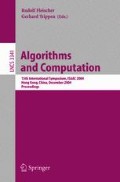Abstract
Standard methods for role assignment partition the vertex set of a graph in such a way that vertices in the same class can be considered to have equivalent roles in the graph. Several classes of equivalence relations such as regular equivalence and equitable partitions have been proposed for role assignment, but they all suffer from the strictness of classifying vertices into being either equivalent or not. It is an open problem how to allow for varying degrees of similarity. Proposals include ad-hoc algorithmic approaches and optimization approaches which are computationally hard.
In this paper we introduce the concept of structural similarity by relaxation of equitable partitions, thus providing a theoretical foundation for similarity measures which enjoys desirable properties with respect to existence, structure, and tractability.
We gratefully acknowledge financial support from Deutsche Forschungsgemeinschaft (DFG, grant Br 2158/1-2)
Access this chapter
Tax calculation will be finalised at checkout
Purchases are for personal use only
Preview
Unable to display preview. Download preview PDF.
References
Artin, M.: Algebra. Prentice-Hall, Englewood Cliffs (1991)
Barnes, E.R.: An algorithm for partitioning the nodes of a graph. SIAM Journal on Algebraic and Discrete Methods 3, 541–550 (1982)
Batagelj, V., Doreian, P., Ferligoj, A.: An optimizational approach to regular equivalence. Social Networks 14, 121–135 (1992)
Bollobás, B.: Modern Graph Theory. Springer, Heidelberg (1998)
Bonacich, P.: Factoring and weighting approaches to status scores and clique identification. Journal of Mathematical Sociology 2, 113–120 (1972)
Borgatti, S.P., Everett, M.G.: The class of all regular equivalences: Algebraic structure and computation. Social Networks 11, 65–88 (1989)
Borgatti, S.P., Everett, M.G.: Two algorithms for computing regular equivalence. Social Networks 15, 361–376 (1993)
Borgatti, S.P., Everett, M.G.: Models of core/periphery structures. Social Networks 21, 375–395 (1999)
Boyd, J.P., Everett, M.G.: Relations, residuals, regular interiors, and relative regular equivalence. Social Networks 21, 147–165 (1999)
Davis, A., Gardner, B., Gardner, M.: Deep south. The University of Chicago Press (1941)
Diestel, R.: Graph Theory. Springer, New York (2000)
Everett, M.G., Borgatti, S.P.: Regular equivalence: General theory. Journal of Mathematical Sociology 19, 29–52 (1994)
Fiala, J., Paulusma, D.: The computational complexity of the role assignment problem. In: Proceedings of the ICALP 2003, pp. 817–828. Springer, Heidelberg (2003)
Freeman, L.C.: Finding social groups: A meta-analysis of the southern women data. In: Breiger, R., Carley, K.M., Pattison, P. (eds.) Dynamic Social Network Modeling and Analysis, The National Academies Press, Washington (2003)
Godsil, C., Royle, G.: Algebraic Graph Theory. Springer, Heidelberg (2001)
Grätzer, G.: General Lattice Theory. Birkhäuser, Basel (1998)
Kratochvíl, J.: Perfect Codes in General Graphs. Academia Praha (1991)
Lorrain, F., White, H.C.: Structural equivalence of individuals in social networks. Journal of Mathematical Sociology 1, 49–80 (1971)
Milner, R.: A Calculus of Communicating Systems. LNCS, vol. 92. Springer, Berlin (1980)
Wasserman, S., Faust, K.: Social Network Analysis: Methods and Applications. Cambridge University Press, Cambridge (1994)
White, D.R., Reitz, K.P.: Graph and semigroup homomorphisms on networks of relations. Social Networks 5, 193–234 (1983)
Author information
Authors and Affiliations
Editor information
Editors and Affiliations
Rights and permissions
Copyright information
© 2004 Springer-Verlag Berlin Heidelberg
About this paper
Cite this paper
Brandes, U., Lerner, J. (2004). Structural Similarity in Graphs. In: Fleischer, R., Trippen, G. (eds) Algorithms and Computation. ISAAC 2004. Lecture Notes in Computer Science, vol 3341. Springer, Berlin, Heidelberg. https://doi.org/10.1007/978-3-540-30551-4_18
Download citation
DOI: https://doi.org/10.1007/978-3-540-30551-4_18
Publisher Name: Springer, Berlin, Heidelberg
Print ISBN: 978-3-540-24131-7
Online ISBN: 978-3-540-30551-4
eBook Packages: Computer ScienceComputer Science (R0)

